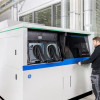For the production of escape route markings for the aircraft of major manufacturers, nozzles printed on the SLA 3D printer Form 3L are used as manufacturing aids - process-safe, modifiable and efficient.
For the production of escape route markings for the aircraft of major manufacturers, nozzles printed on the SLA 3D printer Form 3L are used as manufacturing aids - process-safe, modifiable and efficient.
 New 1-meter Sapphire XC to Begin Shipping in Late Q3 With the First Systems Being Delivered to Several Aerospace Companies
New 1-meter Sapphire XC to Begin Shipping in Late Q3 With the First Systems Being Delivered to Several Aerospace Companies
Velo3D, Inc. (NYSE: VLD), a leading metal additive manufacturing technology company for mission-critical parts, today announced a new addition to its Sapphire family of printers with the Sapphire XC 1MZ. The new printer allows customers to print parts one meter in height—with a total build volume that is twice that of the Sapphire XC and nine times larger than the original Sapphire—increasing the addressable use-cases of Velo3D’s end-to-end metal additive manufacturing solution.
 Launcher depends on Velo3D to 3D print complex rocket components for low-cost, small satellite delivery systems
Launcher depends on Velo3D to 3D print complex rocket components for low-cost, small satellite delivery systems
Humankind launched the first orbital satellite in October of 1957. Sixty-five years later, more than 5,000 satellites are in service, with roughly half of them placed into low earth orbit (LEO) over the past two years. Much but not all of this activity comes courtesy of entrepreneur Elon Musk, whose SpaceX-launched satellite internet constellation Starlink will soon account for at least half of the objects circling our planet.
 The aviation industry is facing profound changes. Sustainability is also determining future planning here. In the course of decarbonising air traffic, hydrogen engines are increasingly coming into focus. And thanks to technological advances, urban, electric aviation is no longer a vision of the future.
The aviation industry is facing profound changes. Sustainability is also determining future planning here. In the course of decarbonising air traffic, hydrogen engines are increasingly coming into focus. And thanks to technological advances, urban, electric aviation is no longer a vision of the future.
 Launcher depends on Velo3D to 3D print complex rocket components for low-cost, small satellite delivery systems
Launcher depends on Velo3D to 3D print complex rocket components for low-cost, small satellite delivery systems
Humankind launched the first orbital satellite in October of 1957. Sixty-five years later, more than 5,000 satellites are in service, with roughly half of them placed into low earth orbit (LEO) over the past two years. Much but not all of this activity comes courtesy of entrepreneur Elon Musk, whose SpaceX-launched satellite internet constellation Starlink will soon account for at least half of the objects circling our planet.
 As metal additive technology continues to gain momentum in the design and industrial production of new aerospace components, GE Aviation’s Loyang facility is the first maintenance, repair and overhaul (MRO) facility worldwide that has been approved to use metal additive manufacturing for commercial jet engine component repairs.
As metal additive technology continues to gain momentum in the design and industrial production of new aerospace components, GE Aviation’s Loyang facility is the first maintenance, repair and overhaul (MRO) facility worldwide that has been approved to use metal additive manufacturing for commercial jet engine component repairs.
 Aerojet Rocketdyne uses metal 3D printing technology from Velo3D to make a critical flight component lighter, smaller, and much less expensive than its predecessors
Aerojet Rocketdyne uses metal 3D printing technology from Velo3D to make a critical flight component lighter, smaller, and much less expensive than its predecessors
On the afternoon of December 19, 1972, Apollo 17’s command and service module CSM-114 “America” splashed down in the Pacific Ocean, bringing its crew and cargo safely home. The event marked the end of NASA’s eleven-year lunar program and humankind’s final visit to the Moon. Thanks in part to Los Angeles, Calif.-based Aerojet Rocketdyne—a manufacturer with a proud heritage in spaceflight and rocket propulsion—we’ll be going back soon, this time to stay.
 Solution has potential to Reduce Costs by 80% and Save $10s of Millions Annually
Solution has potential to Reduce Costs by 80% and Save $10s of Millions Annually
The US Air Force has awarded Optomec a $1.5 million contract to develop a Metal Additive Manufacturing system and process that enables the repair of oversized titanium components used in aircraft engines.
 NASA-developed GRCop-42 alloy delivers the conductivity of copper with high strength for aerospace applications, such as rocket engine combustion chambers
NASA-developed GRCop-42 alloy delivers the conductivity of copper with high strength for aerospace applications, such as rocket engine combustion chambers
 As metal additive technology continues to gain momentum in the design and industrial production of new aerospace components, GE Aviation’s Loyang facility is the first maintenance, repair and overhaul (MRO) facility worldwide that has been approved to use metal additive manufacturing for commercial jet engine component repairs.
As metal additive technology continues to gain momentum in the design and industrial production of new aerospace components, GE Aviation’s Loyang facility is the first maintenance, repair and overhaul (MRO) facility worldwide that has been approved to use metal additive manufacturing for commercial jet engine component repairs.
Velo3D’s End-to-End Solution Deployed in Lockheed Martin’s Additive Design & Manufacturing Center
 Aerojet Rocketdyne uses metal 3D printing technology from Velo3D to make a critical flight component lighter, smaller, and much less expensive than its predecessors
Aerojet Rocketdyne uses metal 3D printing technology from Velo3D to make a critical flight component lighter, smaller, and much less expensive than its predecessors
On the afternoon of December 19, 1972, Apollo 17’s command and service module CSM-114 “America” splashed down in the Pacific Ocean, bringing its crew and cargo safely home. The event marked the end of NASA’s eleven-year lunar program and humankind’s final visit to the Moon. Thanks in part to Los Angeles, Calif.-based Aerojet Rocketdyne—a manufacturer with a proud heritage in spaceflight and rocket propulsion—we’ll be going back soon, this time to stay.
 Report made public by Metropolitan State University of Denver delivers qualification data for Antero® 840CN03 for additively manufactured end-use parts requiring high thermal and chemical resistance, and ESD properties
Report made public by Metropolitan State University of Denver delivers qualification data for Antero® 840CN03 for additively manufactured end-use parts requiring high thermal and chemical resistance, and ESD properties